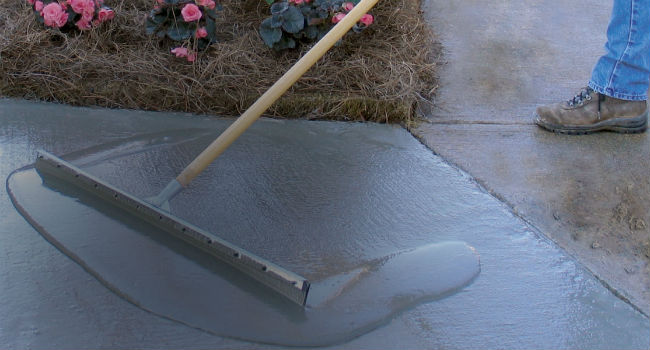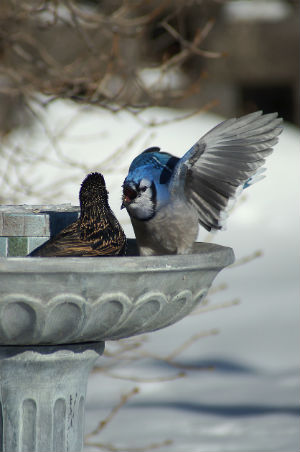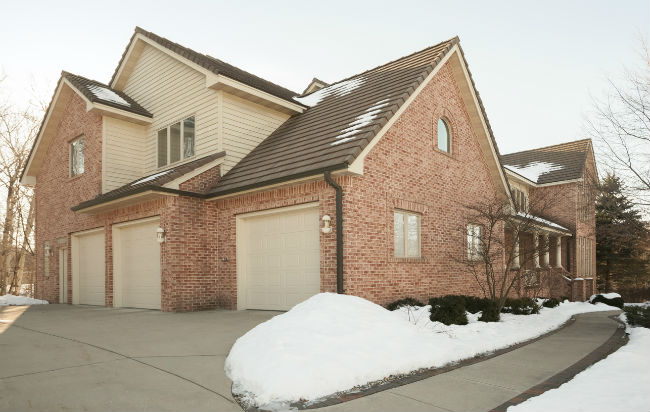We may earn revenue from the products available on this page and participate in affiliate programs. Learn More ›
If you’re a homeowner in the process of winterizing your property, by late fall you’ve probably already replaced the old weather stripping on the exterior doors, cleaned your home’s gutters, and caulked around drafty windows—all in anticipation of the arrival of Old Man Winter. But have you taken any steps to protect your outdoor concrete from the coming cold? While concrete is one of the most durable construction materials around, you may be surprised to learn that sidewalks, patios, birdbaths, and other concrete items around your house can suffer from exposure to snow and ice, and from winter’s freezing temperatures.
Unless it has been sealed, concrete is porous—meaning, of course, that it’s not impervious to moisture. In warm weather, excess rainwater or dew caught in concrete can readily evaporate, but when temps dip below 32 degrees Fahrenheit that moisture freezes and expands. The movement caused by temperature fluctuations can result in cracks in concrete or surface spalling (when the top layer of concrete flakes away to reveal pitted patches). Plus, once cracked, a concrete surface is at even greater risk of damage because water can seep into the cracks and exert intense pressure as it freezes, widening existing cracks and weakening the structural stability of the concrete. In the case of slab concrete, such as patios and sidewalks, water that seeps through large cracks can saturate the ground beneath, causing the ground to heave upward when water in the soil freezes and expands. This movement creates an uneven and potentially dangerous walking surface.
Luckily, you’ve got time to stop the seasonal cycle of damage before it starts. If you’re serious about winterizing, it makes good sense to expand your fall to-do list to include a few smart practices that will protect your concrete from winter’s damaging freeze-thaw cycle.
1. Patch and Repair
Are your concrete slabs already showing signs of damage—for instance, cracks up to a quarter-inch wide or surface spalling? The best way to prevent the damage from spreading with the changing of the seasons—not to mention the best way to ensure that a surface sealer will adhere—is to repair the damage first. The good news is that as long as the slab is still level, you can repair it yourself.
Crack Repair
To stop the progression of cracks, fill them with a flexible sealant, such as Quikrete’s Polyurethane Concrete Crack Sealant. When applied according to the manufacturer’s instructions, Polyurethane Concrete Crack Sealant forms a watertight bond with the surface that visually blends with the texture of the concrete. When dry, the sealant still retains a degree of flexibility and will not pull away from the sides of the crack, even as the concrete expands or contracts imperceptibly as a result of temperature fluctuations.
Slabs with extensive damage (for example, heaving, uneven surfaces or numerous cracks larger than one-quarter inch) may require professional repair. If you’re concerned about the stability of a concrete slab, consult a reputable concrete contractor for advice before attempting repairs.
A Surface Spalling Solution
Strengthen and restore patchy concrete slabs to their former glory before you seal their surfaces to withstand the rough weather ahead. A handy do-it-yourselfer can accomplish this easily and affordably with the help of a resurfacer, such as Quikrete’s Concrete Resurfacer. The successful application of Concrete Resurfacer requires that you first clean away all dirt, grime, and grease with a power washer before applying the resurfacing mixture with a long-handled squeegee. Concrete Resurfacer bonds with the existing concrete and creates a virtually seamless surface for older sidewalks, driveways, and patios.

Once repairs and resurfacing have been completed, be sure to seal your like-new concrete surface with Concrete Cure & Seal to keep it looking freshly poured for years to come.
2. Seal Concrete Surfaces
Sealing is arguably the best way to protect concrete slab surfaces, and doing this before temperatures drop will help prevent the moisture in ice and snow from soaking into the concrete surface and weakening it when it freezes. If your concrete is in decent shape—or if you’ve recently made a few repairs to get it back into shape—you can apply a good acrylic sealer, such as Quikrete’s Concrete Cure & Seal, to protect it from the frigid temperatures to come.

Though it goes on clear, Concrete Cure & Seal enhances your cool slab with an attractive satin finish that offers protection against water as well as the harsh chemicals and salts used to de-ice walkways and steps during winter. One gallon of Concrete Cure & Seal will effectively seal approximately 150 to 200 square feet of concrete. For best results, Concrete Cure & Seal can be reapplied annually after power washing to remove traces of previously applied sealant.
3. Winterizing Concrete Statuary
Unpainted concrete statuary and garden art can also be sealed to help prevent winter damage, but you can better shield these exposed surfaces by taking additional measures. For example, move lighter items, such as stepping stones and other small concrete fixtures, to a storage shed or garage where they won’t be subjected to freezing moisture. If that’s not feasible, drain and invert birdbath and fountain bowls, and cover them (as well as any statuary or other decorative concrete objects) with a tarp tied down securely with string. (It’s important to drain bowls first! Standing water in concrete bowls can expand to such an extent when it freezes that it can crack the bowls even if they’re sealed!)
If you want to provide water for your feathered friends all winter long without running the risk of broken concrete, you can run an electric birdbath water heater from the nearest outdoor electrical outlet to the birdbath, which will prevent the standing water from freezing. Your birdbath will survive the winter, and any birds who haven’t migrated will appreciate having a place to drink when other water sources have frozen.
This content has been brought to you by Quikrete. Its facts and opinions are those of BobVila.com.


